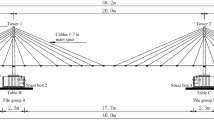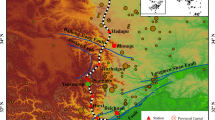Abstract
A pile–soil–cable-stayed 1/70-scale bridge model was designed and constructed to represent an extremely long-span cable-stayed bridge with a 1400-m central span. Shaking table tests were conducted to investigate the wave-passage effects on the seismic responses of the pile–soil–cable-stayed bridge model under uniform and non-uniform longitudinal excitations. Additionally, the acceleration frequency spectra and seismic responses of the bridge model were separately evaluated to compare the effects of uniform and non-uniform excitation. Finally, a 3-D finite element model in OpenSees was built for comparison with the test results. The results showed that the longitudinal wave-passage excitations considerably impacted the acceleration frequency spectra in the vertical direction of the girder and the modal participation factor, which resulted in the symmetric vertical bending mode shapes of the girder to increasingly affect the seismic response as the wave-propagation velocity decreased. The longitudinal wave-passage excitations increased the vertical responses at the 1/2-span of the girder, whereas they generally decreased the longitudinal responses of the girder and tower, as compared with uniform excitation. The longitudinal wave-passage excitations had different impacts on the pile–soil interaction effects for the three studied structural systems of the pile–soil–cable-stayed bridge model. Moreover, the dynamic characteristics and seismic responses obtained from the numerical simulations were consistent with the experimental results.


































Similar content being viewed by others
References
Abdelraheem S (2011) ToshiroHayashikawa, and UweDork, Ground motion spatial variability effects on seismic response control of cable-stayed bridges. Earthq Eng Eng Vib 10(1):37–49
Allam SM, Datta TK (2004) Seismic response of a cable-stayed bridge deck under multi-component non-stationary random ground motion. Earthq Eng Struct Dynam 33(3):375–393
Benedettini F, Gentile C (2011) Operational modal testing and FE model tuning of a cable-stayed bridge. Eng Struct 33(6):2063–2073
Boulanger RW, Curras CJ, Kutter BL et al (1999) Seismic soil-pile-structure interaction experiments and analyses. J Geotech Geoenviron Eng 125(9):750–759
Chang KC, Mo YL, Chen CC et al (2004) Lessons learned from the damaged chi-lu cable-stayed bridge. J Bridge Eng 9(4):343–352
Chen Y-p, Zhou H-y (1996) Seismic behavior of cable-stayed bridges under travelling wave excitation. China Civil Eng J 29(6):61–68 (in Chinese)
Fang Z-Z, Zhang C, Chen Y-J et al (2012) Research on the shaking table test of three towers cable-stayed bridge based on three shaking table system. China Civil Eng J 45(S1):25–29 (in Chinese)
Gao W-J, Tang G-W, Huang F-W et al (2013) Shaking table test study of North main bridge of Xiazhang sea-crossing bridge. Bridge Constr 43(4):7–13 (in Chinese)
Harris HG, Sabnis GM (1999) Structural modeling and experimental techniques. CRC Press, Baco Raton
Johnson N, Ranf R, Saiidi M, Sanders D, Eberhard M (2008) Seismic testing of a two-span reinforced concrete bridge. J Bridge Eng 13(2):173–182
Li C, Li H-N, Hao H et al (2018) Seismic fragility analyses of sea-crossing cable-stayed bridges subjected to multi-support ground motions on offshore sites. Eng Struct 165:441–456
Lin J, Zhang Y, Li QS et al (2004) Seismic spatial effects for long-span bridges, using the pseudo excitation method. Eng Struct 26(9):1207–1216
Mazzoni S, McKenna F, Scott MH et al (2006) Open system for earthquake engineering simulation (OpenSees). OpenSees command language manual. Pacific Earthquake Engineering Research Center, University of California, Berkeley
Meymand PJ (1998) Shaking table scale model tests of nonlinear soil-pile-superstructure interaction in soft clay, vol 1. University of California, Berkeley
Soyluk K, Dumanoglu AA (2004) Spatial variability effects of ground motions on cable-stayed bridges. Soil Dyn Earthq Eng 24(3):241–250
Soyluk K, Sicacik EA (2012) Soil–structure interaction analysis of cable-stayed bridges for spatially varying ground motion components. Soil Dyn Earthq Eng 35:80–90
Sun L, Xie W (2019) Full-model shaking table tests of seismic behavior of a super-long-span cable-stayed bridge with pile foundations. J Bridge Eng 24(11):04019102
Taucer FF, Spacone E, Filippou FC (1991) A fiber beam-column element for seismic response analysis for reinfored concrete structures. 1991, Report No. UCB/EERC-91/17 Earthquake Engineering Research Center College of Engineering University of California: Berkeley
Tian Z-Y, Lou M-L (2014) Traveling wave resonance and simplified analysis method for long-span symmetrical cable-stayed bridges under seismic traveling wave excitation. Shock Vib 2014:602825
Van Overschee P, De Moor B (2012) Subspace identification for linear systems: theory-implementation-applications. Springer, Berlin
Wilson DW (1998) Soil-pile-superstructure interaction in liquefying sand and soft clay. Citeseer, London
Wilson JC (2003) Repair of new long-span bridges damaged by the 1995 Kobe earthquake. J Perf Const Facilit 17(4):196–205
Xiang H-f (1983) Earthquake response analysis of cable-stayed bridges under the action of travelling waves. J Tongji Univ (Natural Science) 2:4–12 (in Chinese)
Xie W, Sun L (2019) Experimental and numerical verification on effects of inelastic tower links on transverse seismic response of tower of bridge full model. Eng Struct 182:344–362
Yan X-y, Li Z-x, Han Q et al (2013) Shake tables test study on seismic response of a long-span rigid-framed bridge under multi-support excitations. China Civil Eng J 46(7):81–89 (in Chinese)
Yan J-k, Li J-z, Peng T-b et al (2016) Shake table tests and numerical analysis for travelling wave effect of a three-tower two-span suspension bridge. J Vib Shock 35(7):44–48 (in Chinese)
Yang C-Y, Cheung MMS (2011) Shake table test of cable-stayed bridge subjected to non-uniform excitation. Proc Eng 14:931–938
Zhong J, Jeon JS, Yuan W et al (2017) Impact of spatial variability parameters on seismic fragilities of a cable-stayed bridge subjected to differential support motions. J Bridge Eng 22(6):04017013
Zhou R, Zong Z-H, Huang X-Y et al (2014) Seismic response study on a multi-span cable-stayed bridge scale model under multi-support excitations. Part II: numerical analysis. J Zhejiang Univ Sci A 15(6):405–418
Zong Z-H, Zhou R, Huang X-Y et al (2014) Seismic response study on a multi-span cable-stayed bridge scale model under multi-support excitations. Part I: shaking table tests. J Zhejiang Univ Sci A 15(5):351–363
Acknowledgements
This study was supported by the National Natural Science Foundation of China (Grant Numbers: 51608282 and 91515101-5). The authors thank Profs. Fayun Liang, Qingjun Chen, and Wancheng Yuan from Tongji University, who provided constructive comments regarding the shaking table tests. The authors are also grateful for the graduate students, Miss. Dan Nie, Mr. Jianguo Wang, Mr. Yajie Jia, Mr. Haibing Chen, Mr. Sheng Jiao, Mr. Yaohua Yang, and Mr. Chao Luo from Tongji University, and Dr. Chengyu Yang from the State Key Laboratory for Disaster Reduction in Civil Engineering for their dedicated assistance during the tests.
Author information
Authors and Affiliations
Corresponding author
Additional information
Publisher's Note
Springer Nature remains neutral with regard to jurisdictional claims in published maps and institutional affiliations.
Rights and permissions
About this article
Cite this article
Xie, W., Sun, L. & Lou, M. Wave-passage effects on seismic responses of pile–soil–cable-stayed bridge model under longitudinal non-uniform excitation: shaking table tests and numerical simulations. Bull Earthquake Eng 18, 5221–5246 (2020). https://doi.org/10.1007/s10518-020-00910-3
Received:
Accepted:
Published:
Issue Date:
DOI: https://doi.org/10.1007/s10518-020-00910-3




